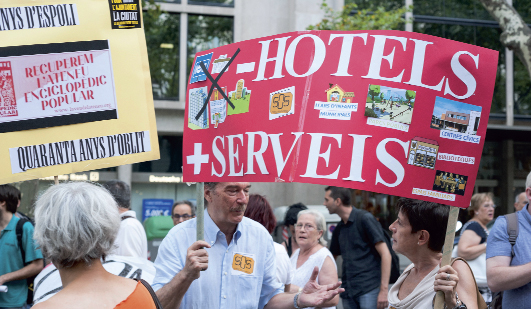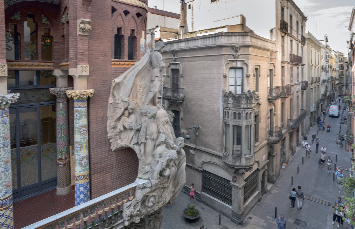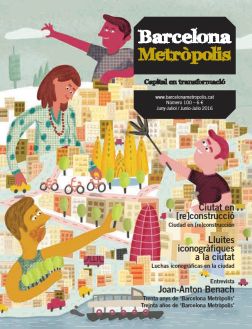Fighting the abuse of power by politicians and their parties; preventing private economic powers and their networks from influencing issues of general interest. This is a proposal for political construction with the involvement of people and designed to promote their freedom.
Dedicated to activists I continue to learn from: Maria Mas and Daniel Jiménez Schlegl

Photo: Dani Codina.
A demonstration by residents in July 2015 against converting the Deutsche Bank building into a hotel at the junction of Avinguda Diagonal and Passeig de Gràcia.
Upon receiving the Optimistas Comprometidos (Committed Optimists) award in Madrid in May, Egyptian doctor and writer Nawal El Saadawi proclaimed that “democracy is not freedom”. With this simple statement, she delivered a coup de grace to one of the most promulgated lies in our western society.
Democracy is not freedom; nor is participation as we now know it. It is my own personal experience that leads me to agree with the words of Nawal El Saadawi. In 2002, and with the support of people in the “Another Plaça Lesseps is possible” movement, I began my research on and activities in citizen participation and urban planning. Working as an independent specialist, I became a mediator between residents and the different businesses with whom the City Council had partnered to achieve its urban planning objectives. My administrative work brought me into contact with a small nuclei of resistance comprised of longstanding neighbourhood associations as well as newly formed groups who were just developing the arts of dissidence they would use against the city government’s formidable propaganda machinery.
Unfortunately, the creative and transformative abilities of many people who committed their loyalty to the city government in the late 1970s and 1980s had waned due to a growing tendency to outsource projects. The transformative and supportive power of residents ran up against the self-sufficient arrogance of City Council administrators and project managers evermore detached from everyday realities. This progressive loss of empathy by our local government was my main reason for committing to the recovery of its original raison d’être and its mission of service to the people and the city.
In the Lesseps case, the flexibility not only of the City Council administration but also of the political groups within the council body demonstrated that it was possible to build a Plaça Lesseps different to the one that had initially been planned. The unexpected nature of the residents’ demands coupled with a participatory process organised at a grass-roots level and open to all citizen and institutional stakeholders were undoubtedly key to achieving mediation between them and the City Council’s project specialists. I never again saw a similar process until five years ago when Hostafrancs residents and architects from the LaCol cooperative occupied the “Bloc 11” buildings in Can Batlló.
A few years later, that collective success led to an invitation from then Mayor Jordi Hereu’s staff for me to join the city government as a councilmember representing Ciutat Vella. This was around 2007, when I joined a large group to debate whether citizen participation could be included within the urban planning process. I thought that a process similar to Lesseps would not be possible, as it had originated as an unplanned action with no formal rules for participation. As there had been no monitoring by the city council or the Catalan government, it was a process borne out of a real need of the people, as opposed to a top-down movement. At that time, I spoke like someone who had lost confidence in the ability of institutions to transform and adapt to mature political actions organised by people and neighbourhood residents.
The city’s design: a collective task
Looking back on why I agreed to join the city government, I realise the critical importance of my confidence in the methodology of combined citizen and government actions that had been implemented in Lesseps. That was not a participatory process, but rather a citizen action to claim a right to influence the city’s design and work in a cooperative, egalitarian way with the City Council’s civil servants. There, together, we accomplished something that we had been told was impossible. We achieved a critical level of effectiveness and made extraordinary accomplishments in terms of technical and urban design criteria. We took the time to get together and debate and would not settle for the arguments put forth in the executive plan, which was displayed publically at the Gràcia District Office. All this happened because we never had any doubt that it was our responsibility to do something better that what had been planned.
Once we had got past the administrative and institutional reality of the Barcelona City Council, I was once again reminded of the abilities and value of municipal staff members. We were able to design and implement decisive actions in the neighbourhood to improve local life through the initiative and demands of local associations and activists. We regulated the use of tourist flats and closed them when necessary; in a plenary session, we enacted a definitive ban on the building of more hotels in Ciutat Vella, as well as a usage plan that restored the balance between resident and floating populations; we stopped the so-called Barceloneta “Lifts Plan”, which was transformed into a neighbourhood plan.
What I had not anticipated, however, was the reality of arbitrary decision-making power. In spite of the representative influence and power that being an elected official would supposedly bestow on me, we were unable to stop the Palau de la Música hotel project. This mission impossible was once again down to the struggle and perseverance of residents who unmasked the farce of “general interest” that was used to justify urban planning nonsense at the expense of our public heritage and educational infrastructure.

Photo: Dani Codina.
The Palau de la Música; centre, the Agustí Valentí house, on the corner of Carrer Amadeu Vives and Carrer Sant Pere Més Alt, opposite the Palau. This listed property was where the Palau hotel was slated to be built following an urban land use reclassification.
The realisation that our system of political representation would be considered as democratic even when legally justified and well-founded citizen arguments were dismissed is what abruptly catapulted me out of the institution. Shortly thereafter I witnessed the implementation of coherent actions undertaken by residents and the Public Prosecutor against the Palau hotel and its planning scheme. I participated as a witness in the investigative phase of the case and a few years later in the trial. As had happened to me in Lesseps, in the company of free and self-organising citizens, I experienced the strength and dignity that comes from taking part in an initiative against entrenched powers.
Does real political action exist beyond our current institutions and the representative mechanisms afforded by our democracy’s system of political parties? I would offer proposals for direct democracy through new citizens’ institutions such as the Driving Committee of the Citizens’ Parliament and initiatives such as the Citizen Municipal Observatory Network and the Citizen Observatory against Corruption.
Fighting the abuse of power by politicians and their parties; preventing private economic powers and their networks from influencing issues of general interest. This is a proposal for political construction with the involvement of people and designed to promote their freedom.
If we add to Nawal El Saadawi’s assertion that “democracy is not freedom” the idea that freedom is something that we do, we will have identified the starting point and the way forward for all future processes of radical and critical free thinking in our cities. We will have citizens’ initiatives served by our government administrations and their specialists; infrastructures will be built on the basis of trust and partnerships between city residents and those who design administrative protocols; we will have creativity and infinite possibilities for citizen actions to transform the city and create new institutional structures.



